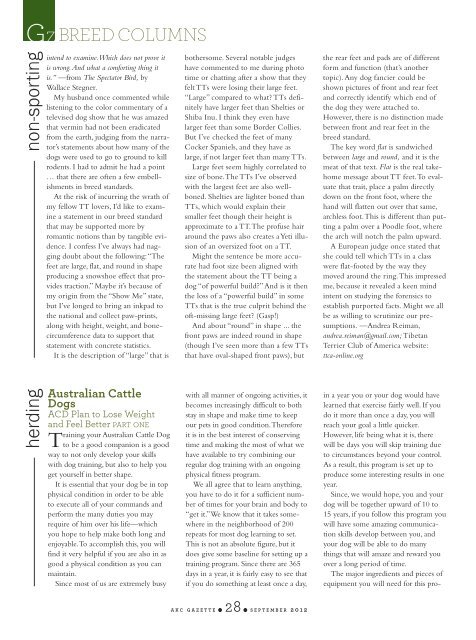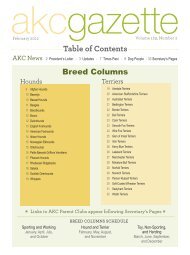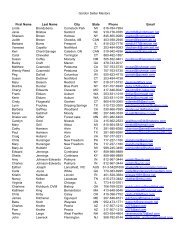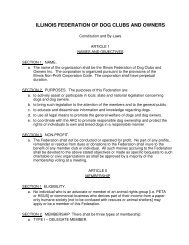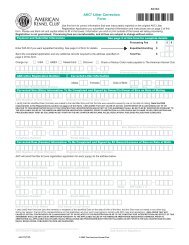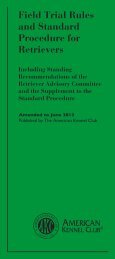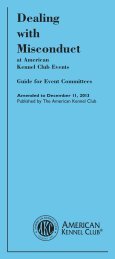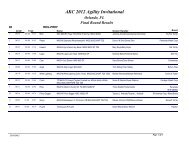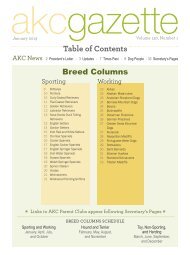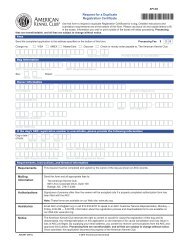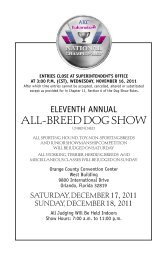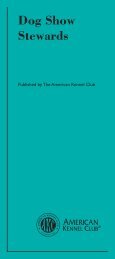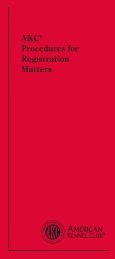Download - Parent Directory - American Kennel Club
Download - Parent Directory - American Kennel Club
Download - Parent Directory - American Kennel Club
- No tags were found...
You also want an ePaper? Increase the reach of your titles
YUMPU automatically turns print PDFs into web optimized ePapers that Google loves.
GZ BREED COLUMNSnon-sportingintend to examine. Which does not prove itis wrong. And what a comforting thing itis.” —from The Spectator Bird, byWallace Stegner.My husband once commented whilelistening to the color commentary of atelevised dog show that he was amazedthat vermin had not been eradicatedfrom the earth, judging from the narrator’sstatements about how many of thedogs were used to go to ground to killrodents. I had to admit he had a point… that there are often a few embellishmentsin breed standards.At the risk of incurring the wrath ofmy fellow TT lovers, I’d like to examinea statement in our breed standardthat may be supported more byromantic notions than by tangible evidence.I confess I’ve always had naggingdoubt about the following: “Thefeet are large, flat, and round in shapeproducing a snowshoe effect that providestraction.” Maybe it’s because ofmy origin from the “Show Me” state,but I’ve longed to bring an inkpad tothe national and collect paw-prints,along with height, weight, and bonecircumferencedata to support thatstatement with concrete statistics.It is the description of “large” that isbothersome. Several notable judgeshave commented to me during phototime or chatting after a show that theyfelt TTs were losing their large feet.“Large” compared to what? TTs definitelyhave larger feet than Shelties orShiba Inu. I think they even havelarger feet than some Border Collies.But I’ve checked the feet of manyCocker Spaniels, and they have aslarge, if not larger feet than many TTs.Large feet seem highly correlated tosize of bone. The TTs I’ve observedwith the largest feet are also wellboned.Shelties are lighter boned thanTTs, which would explain theirsmaller feet though their height isapproximate to a TT. The profuse hairaround the paws also creates a Yeti illusionof an oversized foot on a TT.Might the sentence be more accuratehad foot size been aligned withthe statement about the TT being adog “of powerful build?” And is it thenthe loss of a “powerful build” in someTTs that is the true culprit behind theoft-missing large feet? (Gasp!)And about “round” in shape ... thefront paws are indeed round in shape(though I’ve seen more than a few TTsthat have oval-shaped front paws), butthe rear feet and pads are of differentform and function (that’s anothertopic). Any dog fancier could beshown pictures of front and rear feetand correctly identify which end ofthe dog they were attached to.However, there is no distinction madebetween front and rear feet in thebreed standard.The key word flat is sandwichedbetween large and round, and it is themeat of that text. Flat is the real takehomemessage about TT feet. To evaluatethat trait, place a palm directlydown on the front foot, where thehand will flatten out over that same,archless foot. This is different than puttinga palm over a Poodle foot, wherethe arch will notch the palm upward.A European judge once stated thatshe could tell which TTs in a classwere flat-footed by the way theymoved around the ring. This impressedme, because it revealed a keen mindintent on studying the forensics toestablish purported facts. Might we allbe as willing to scrutinize our presumptions.—Andrea Reiman,andrea.reiman@gmail.com; TibetanTerrier <strong>Club</strong> of America website:ttca-online.orgherdingAustralian CattleDogsACD Plan to Lose Weightand Feel Better PART ONETraining your Australian Cattle Dogto be a good companion is a goodway to not only develop your skillswith dog training, but also to help youget yourself in better shape.It is essential that your dog be in topphysical condition in order to be ableto execute all of your commands andperform the many duties you mayrequire of him over his life—whichyou hope to help make both long andenjoyable. To accomplish this, you willfind it very helpful if you are also in asgood a physical condition as you canmaintain.Since most of us are extremely busywith all manner of ongoing activities, itbecomes increasingly difficult to bothstay in shape and make time to keepour pets in good condition. Thereforeit is in the best interest of conservingtime and making the most of what wehave available to try combining ourregular dog training with an ongoingphysical fitness program.We all agree that to learn anything,you have to do it for a sufficient numberof times for your brain and body to“get it.” We know that it takes somewherein the neighborhood of 200repeats for most dog learning to set.This is not an absolute figure, but itdoes give some baseline for setting up atraining program. Since there are 365days in a year, it is fairly easy to see thatif you do something at least once a day,in a year you or your dog would havelearned that exercise fairly well. If youdo it more than once a day, you willreach your goal a little quicker.However, life being what it is, therewill be days you will skip training dueto circumstances beyond your control.As a result, this program is set up toproduce some interesting results in oneyear.Since, we would hope, you and yourdog will be together upward of 10 to15 years, if you follow this program youwill have some amazing communicationskills develop between you, andyour dog will be able to do manythings that will amaze and reward youover a long period of time.The major ingredients and pieces ofequipment you will need for this pro-A K C G A Z E T T E • 28 • S E P T E M B E R 2 0 1 2


